U.S.
AnalysisInside the successes, missteps and failures of Biden's early presidency
The Washington Post October 22, 2022
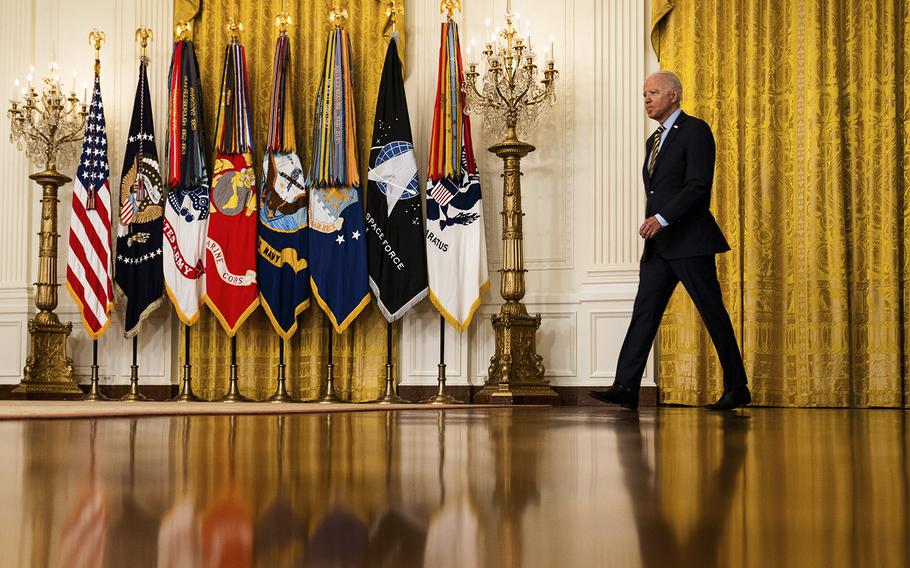
President Biden arrives in the East Room of the White House on July 8, 2021, to deliver remarks regarding the Afghanistan drawdown. (Demetrius Freeman/Washington Post)
WASHINGTON - President Biden gathered his advisers, with mounting frustration, as televised images and classified cables tracked in real time the unraveling of his long-planned withdrawal from Afghanistan.
Even fellow Democrats, friends he had known for years, had begun to criticize the chaotic withdrawal - the frenzied mobs at the airport, the desperate Afghans clinging to planes - and he didn't understand why they weren't appearing on television to defend him and his decision.
"Call them. Call their offices," an exasperated Biden ordered his aides in August 2021, according to someone familiar with the president's demand. "See why they're not out there."
What the president did not understand was that the problem was not a lack of television bookers. The problem instead was that most of his allies were unwilling to publicly defend him against the images from overseas.
Just months earlier, Biden had been riding high, predicting "a summer of freedom, a summer of joy." His approval ratings hovered in the mid-50s, the coronavirus was in retreat, and the economy booming.
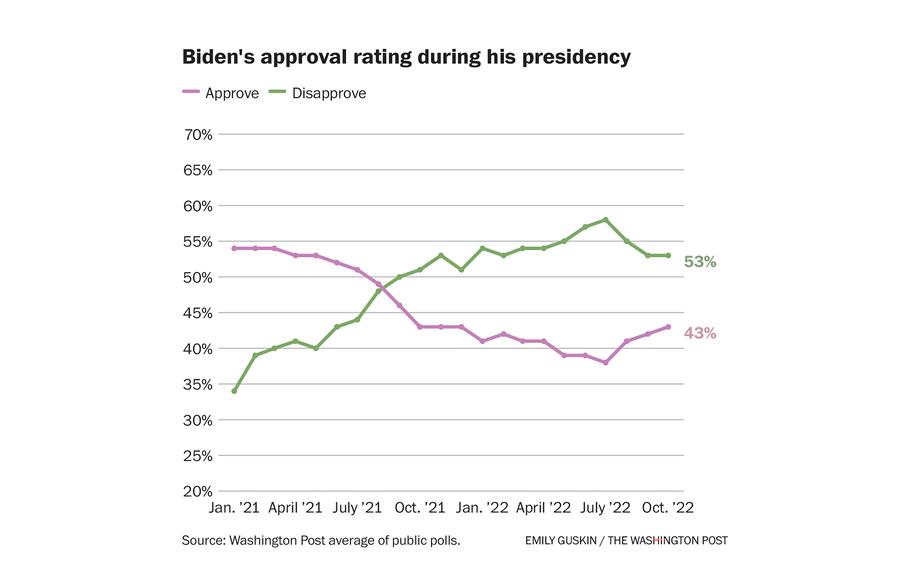
(Emily Guskin)
But that was all about to come undone.
Now, with the delta variant spreading, staff were once again wearing masks in the White House. Inflation was proving less transitory than the administration had insisted. The legislative gears were grinding to a halt amid Democratic infighting. Americans in the country's longest war were dying once again - undermining Biden's signature promise of strong, steady, stable leadership in contrast to former president Donald Trump. And Biden felt isolated.
"That was when the s--- hit the fan," recalled a person who was part of the response. "That was the beginning of the darkness."
The story of Biden's first term so far is a roller coaster - complicated and contradictory, with remarkable achievements and enormous disappointment. His administration oversaw the most successful vaccine rollout in history, ushering in a post-pandemic sense of normalcy - yet the country is gearing up for new worrisome variants as it heads into winter. And Biden helped mitigate Russia's invasion of Ukraine - while also strengthening the transatlantic alliance and growing NATO - but he did so against a backdrop in which rising prices, fueled in part by his policies, formed the fabric of Americans' daily lives.
For the man who had promised to heal the soul of the nation, the presidency proved a test of his own.
Some people closest to the president describe an administration that achieved significant victories while repeatedly running up against the limits of the federal bureaucracy, a tissue-thin majority in Congress and a deeply divided nation. Aides also often failed to anticipate and plan for worst-case scenarios and regularly set expectations above what they could achieve. Biden and his team were elected on the promise of a new era of competent governance, only to find that the most rigorous science and best expert advice could not protect the country from new waves of disease and economic hardship.
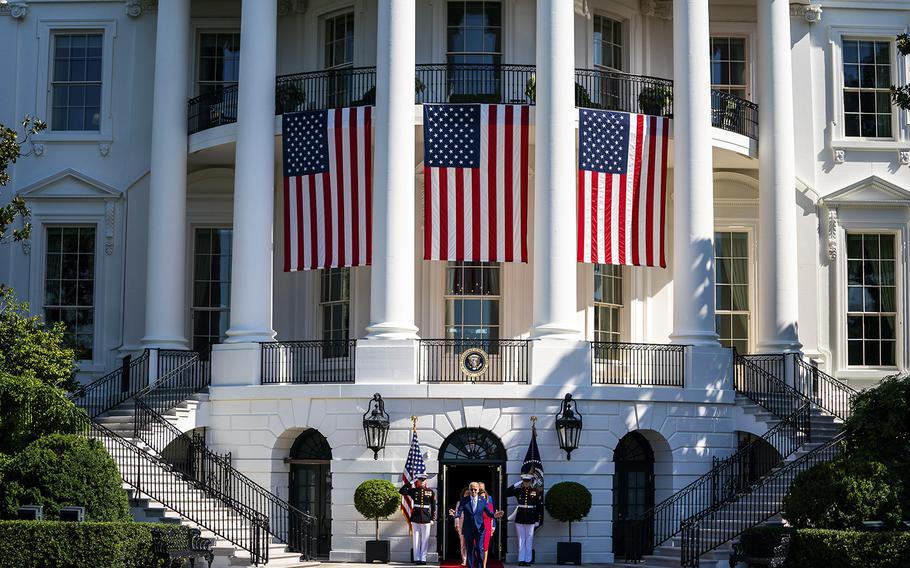
President Biden walks out to the South Lawn to sign into law the CHIPS and Science Act on Aug. 9, 2022. (Demetrius Freeman/Washington Post)
Biden - a tactile, retail politician - found himself stuck in a bubble, both of covid beyond his control and insularity of his own making. The president remains surrounded by a coterie of longtime allies, most of whom have worked for him for decades. Even those with senior titles in the White House say there remains a clear stratification between Biden's trusted inner circle and the rest of the team.
This portrait of Biden's presidency as it approaches the two-year mark is the result of interviews with 80 senior White House officials, Cabinet secretaries, outside allies and Democratic lawmakers and strategists, many of whom spoke on the condition of anonymity to candidly share private details. Many of the scenes and details have not been previously reported.
Ultimately Biden achieved much of what he promised as a candidate. He appointed the first Black woman to the Supreme Court, amid a record pace of judicial appointees that placed more Black women on appellate courts than all prior presidents combined. With the narrowest control of Congress in decades, he passed laws on covid relief, infrastructure, climate change, manufacturing, gun regulation and prescription drug prices that in most cases had spent years on Democratic wish lists.
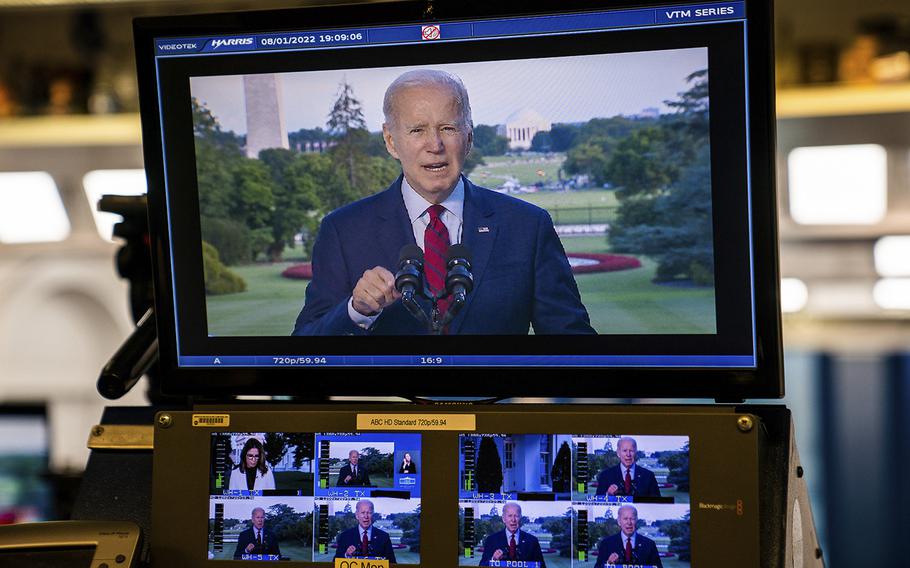
President Biden delivers remarks at the White House on Aug. 1, 2022, on the successful counterterrorism operation that killed al-Qaeda leader Ayman al-Zawahiri. (Demetrius Freeman/Washington Post)
A precision strike he ordered killed the long-standing head of al-Qaeda, and he continues to hold together a jittery coalition of nations to support Ukraine against Russian aggression, bolstering his promise to restore American leadership abroad.
But as inflation rose and coronavirus variants battered the country, he also lost the support of the public, with his approval rating plummeting to below 40 percent this summer - landing him among the presidents with the all-time lowest ratings at the same point during their first terms - before rebounding somewhat in September to match the approval ratings of Ronald Reagan and Bill Clinton at the same point in their presidencies.
A Washington Post-ABC News poll last month found 56 percent of Democrats and Democratic-leaning independents wanted the party to nominate someone other than Biden as its candidate in 2024. At the same time, 75 percent of Democratic leaners said they approved of Biden, and 94 percent of Democratic voters said they would support Biden in a 2024 matchup against Trump.
Just weeks before his first midterm elections, it remains too early to fully assess the accomplishments and defeats of these trying 21 months. Despite Biden's calls for national healing and warnings about existential threats to the nation's democratic institutions, the GOP - a party the president recently lamented was underpinned by "semi-fascism" - appears poised to take control of the House and has a coin-flip chance of winning the Senate, which would force a new political reality on his presidency.
But for those closest to Biden, the trials ultimately vindicate the promises he made to the American people. The senior team around him, which has begun preparations for a reelection campaign, remains confident that his first term will be remembered as a historic success.
"It was true in the campaign and it's true in the White House: Comebacks are always sweeter and more satisfying because of the character they reveal," said Bruce Reed, Biden's deputy chief of staff.
"Washington is a fickle town, politics is a fickle business, and it's easy to move on when the chips are down," Reed continued. "But during the campaign and as president, Biden has hung in through thick and thin, when it was easy to stop believing, and it paid off in ways that it might not have with someone else."
The warning signs appeared early in England.
Weeks after Biden had given a June 2, 2021, speech declaring a summer of relief in the fight against the coronavirus, then-British Prime Minister Boris Johnson announced a delay of "Freedom Day," a celebration of the easing of restrictions in his country. The delta surge, identified months earlier in India, was spreading rapidly.
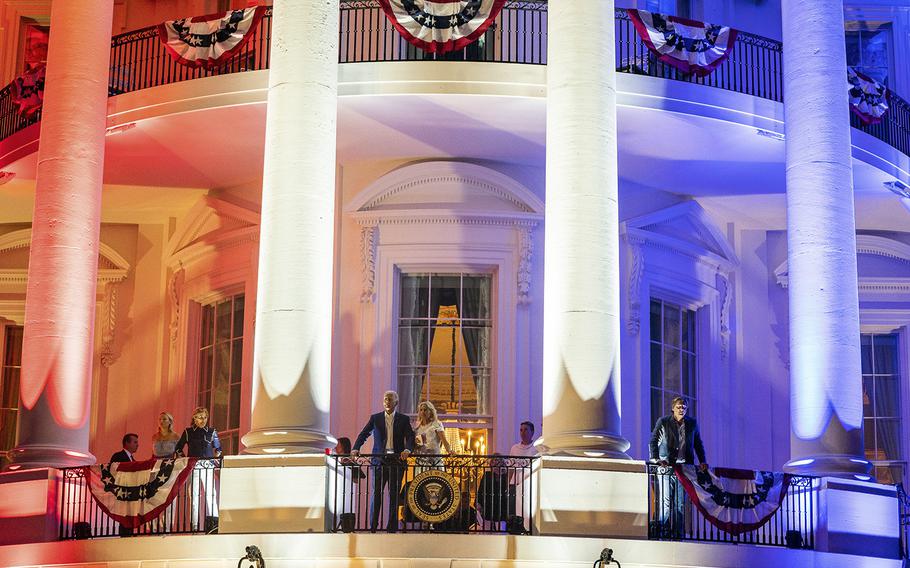
President Biden and first lady Jill Biden watch fireworks during an Independence Day celebration on the South Lawn of the White House last year. (Demetrius Freeman/Washington Post )
But inside the White House, planning for an "independence from the virus" July Fourth celebration barreled inexorably forward. There would be a cookout on the South Lawn, replete with red-white-and-blue crepe lanterns and a fireworks display. Cabinet officials were dispatched to take photos and video of themselves out in the country on the holiday, doing something that conjured a post-covid world - part of a White House strategy to demonstrate that Americans had the tools to live with the virus.
Scientific advisers to the White House were growing increasingly nervous. But there was too much momentum behind the idea of a patriotic celebration of victory over the virus. "If we could have canceled it, we would have canceled it," said one top covid adviser.
From the start, Biden's covid response was anchored around two ideas: He would follow the science, and the science would show the way to ending the pandemic. After his first meeting with his covid team, he gave them a pep talk.
"I know this is going to be hard," the president told his aides. "I know there will be ups and downs. Things will not always go smoothly. But promise me this - you will tell me when there's a problem. You will put it on the table and together we can solve it."
For months afterward, he had a catch phrase he would use. "Tell me what to do, docs," the president would frequently say.
But the reality was more complicated. Pfizer-BioNTech announced after the 2020 elections that their vaccine was more than 90 percent effective at preventing infection. Weeks later, Moderna announced over 94 percent efficacy at preventing infection.
Nearly everything the president and his scientific advisers assumed for the next six months hinged on those numbers, even though it would become clear that summer that the vaccines - though highly effective at stopping death and hospitalization - did a far worse job of blocking infection than originally expected, as potency waned and new, more transmissible variants emerged.
Still, the political imperative remained. As the July Fourth celebration drew closer, Biden flagged to his staff that they needed to add some caveats to his remarks, echoing the warnings he had been issuing about potential variants in the weeks prior. His top advisers worked to scale back the tone - cutting several overly triumphant lines - and added some fine print, with cautions such as "covid-19 has not been vanquished."
But the event went on as planned, and the message delivered was ultimately one of victory: "We are emerging from the darkness," Biden declared in remarks titled, in part, "Independence from COVID-19."
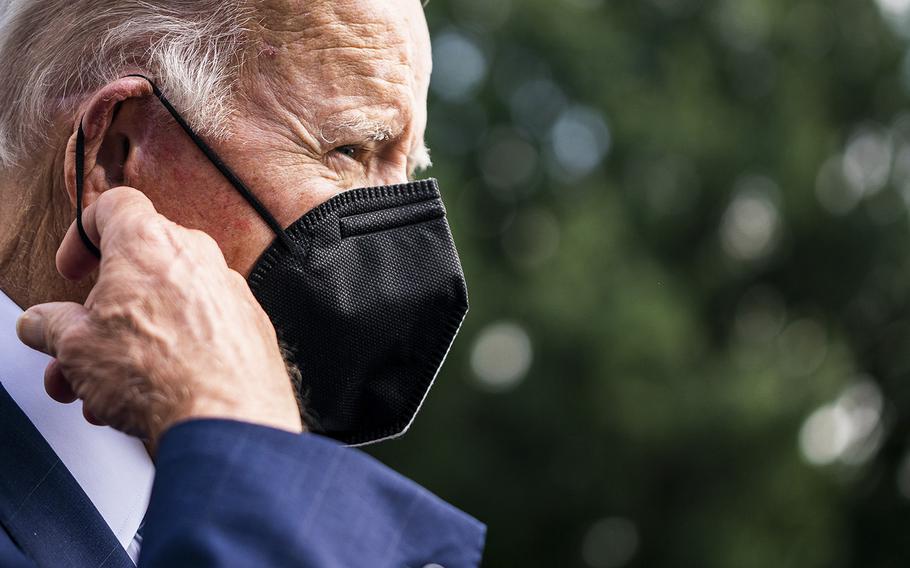
President Biden removes his mask to speak with the press on the South Lawn of the White House on Aug. 26, 2022. (Demetrius Freeman/Washington Post)
Just three weeks later - spurred, in part, by a delta outbreak among a highly vaccinated population in Provincetown, Mass. - the Centers for Disease Control and Prevention recommended that even fully vaccinated people wear masks indoors.
Sixty-two percent of the nation approved of how Biden was handling the coronavirus pandemic in late June, shortly before he gave his speech. But that number fell 10 percentage points, to 52 percent approval, in late August and September and to 47 percent by November, dragging down his overall rating, according to Washington Post-ABC News polling.
"We go with what we know at the time, with the best possible information, with what the experts are telling us, and do our best," said Mike Donilon, a senior Biden adviser.
Heading into August, Biden advisers were exhausted but optimistic, eager to take a week of summer vacation. "No one," said one former White House aide, "expected Afghanistan would become a huge political nightmare."
But that's exactly what happened.
In a meeting immediately before Biden's July announcement of an August deadline for withdrawing troops from Afghanistan, one of the president's senior military advisers had assured him that the drawdown would not be like that of Vietnam, where desperate South Vietnamese refugees had tried to cling to helicopters departing Saigon in 1975.
Just moments later, unplanned and unscripted, Biden repeated that phrase in an exchange with reporters, much to the chagrin of his advisers. "There's going to be no circumstance where you see people being lifted off the roof of an embassy in the - of the United States, from Afghanistan," he said.
Kabul would fall just over five weeks later, forcing a helicopter airlift to the nearby airport and resulting in a cascade of devastating images and news bulletins: Desperate Afghans rushing Kabul International Airport, clinging to the wings of departing planes. Human remains recovered in the wheel well of a U.S. military C-17 after it landed at a Qatari air base. And several other Afghans - including a teenage soccer player - plummeting to their death as the planes lifted into the sky.
One former senior administration official said that inside the White House there was an immediate realization that the images looked "very bad," and aides began privately likening the situation to Saigon. Another person familiar with the dynamic recalled a senior official laying out newspaper front pages from the day - which all featured nearly identical photos from Kabul - as aides were stunned into silence, horrified by the loss of life.
And it would only get worse.
The initial reports of the Aug. 26 bombing outside Kabul airport's gates came around 9 a.m., when Biden was already headed to the Situation Room for a daily meeting on Afghanistan.
Gen. Kenneth "Frank" McKenzie, who oversaw the American departure as the head of the U.S. Central Command, broke in every few minutes as he got more news. About 30 minutes into the meeting, McKenzie told the president, "We have KIA," referring to members of the military killed in action.
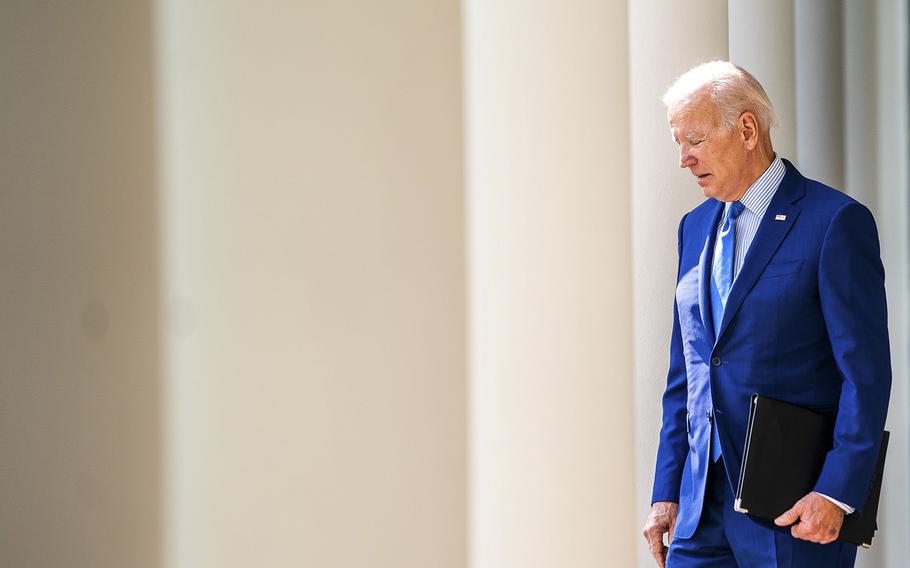
President Biden exits the Oval Office for remarks in the Rose Garden last month. (Demetrius Freeman/Washington Post)
The number of U.S. service members who had been killed ticked up throughout the meeting - with McKenzie providing updates every few minutes. Biden told McKenzie and others still in Kabul to let him know what they needed, and he'd get it to them. He also told them to make whatever decisions they needed to keep their troops safe. In the end, the bombing killed more than 170 people, including 13 U.S. service members.
To the rest of his staff, Biden offered an acknowledgment of the tragedy and an admonition to stay the course: The worst thing that can happen has happened, the president said, and now we move forward.
Although Biden never wavered in his decision to bring U.S. troops home, he was livid, advisers said, with the intelligence community for having underestimated how quickly Kabul would fall. A spokesperson for the intelligence community declined to comment.
Several officials recalled much of the White House grinding to a halt as - for the first time since taking office - even Democrats seemed to abandon the administration. Two chiefs of staff at key agencies, both political appointees, independently fretted that they were witnessing the beginning of the end of Biden's presidency.
Ultimately, the administration took credit for airlifting more than 120,000 people out of Kabul, successfully resettling roughly 80,000 Afghans in the United States. White House officials argue that the withdrawal also likely saved American lives.
But the fear in Biden's ranks was that the damage had been done.
" 'Forget about the midterms,' " a Cabinet secretary's chief of staff said, according to an administration official. " 'This is it.' "
Although the Afghanistan debacle would soon fade from headlines, the withdrawal undermined Biden's image as calm and competent - an anti-Trump - and its shock waves lingered.
Meanwhile, a new political danger was emerging, one that had been magnified as the delta surge began to disrupt the global manufacturing supply chain. The prices of necessities such as apartment rents, milk jugs and cartons of eggs began to creep up, while computer-chip shortages sent automobile prices rocketing.
Biden had come to office with a green light from many of the nation's top economists to spend heavily. During his campaign, both of the former chairs of the Federal Reserve - Ben Bernanke and Janet L. Yellen, his future treasury secretary - had advised him that when it came to pandemic response, there was greater risk in going small than going big. Economists at Wall Street banks were also on board. As late as March 2021, Federal Reserve governors were so confident that they predicted no interest rate increases until 2024 - a date, it would soon turn out, that was off by 21 months.
In retrospect, the risks to kicking off an inflationary spiral were evident all along. Biden's first legislative success, the $1.9 trillion American Rescue Plan, amounted to an injection of money equal to about 9 percent of the U.S. economy, following two previous injections in 2020 worth 15 percent combined, according to the International Monetary Fund.
American bank accounts grew, leading to historic drops in child poverty, a rebound in the labor market, and a drop in evictions. But when coronavirus variants spiked later in the year, the extra cash ran headlong into new supply chain disruptions - problems that were only exacerbated by Russia's invasion of Ukraine that winter.
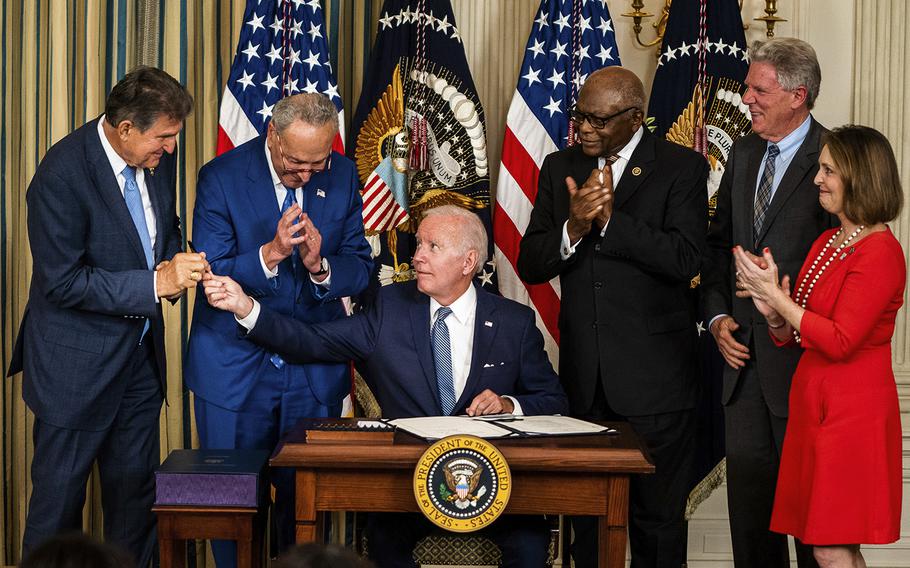
President Biden hands Sen. Joe Manchin III, D-W.Va., the pen used to sign into law the Inflation Reduction Act at the White House on Aug. 16, 2022. (Demetrius Freeman/Washington Post )
Just how much Biden's legislation contributed to the higher prices remains a debate, with administration officials arguing that inflation is a global phenomenon and a smaller covid relief package would not have fundamentally limited domestic inflation. Still, there is broad agreement it added some fuel to the fire.
Inside the White House, even Jared Bernstein, a longtime Biden economic adviser known for his left-leaning views, had concerns over the summer about what impact the massive infusions of printed money - about $500 billion in 2021 alone - would have on inflation.
"It's getting pretty hot in the kitchen," he warned one colleague, according to a person familiar with the statement. (Bernstein said he does not remember making the comment.)
As the inflation rate continued to tick up into the fall, Biden's frustration mounted. He repeatedly asked aides why no one was out on television defending him and his administration against Republican attacks on the issue.
A debate formed inside his inner circle about how they spoke of inflation. Though many economic experts had initially believed inflation would prove "transitory," it was an easily mocked phrase. Biden allies both inside and outside the White House had begun pushing for Biden to give a speech addressing head-on the new reality of rising prices.
But officials said White House Chief of Staff Ron Klain resisted, preferring to focus on the good economic indicators like the strong jobs numbers. If the White House didn't tell its own positive story, he argued in meetings, no one else would. Several senior administration officials - including Brian Deese, director of the National Economic Council - said no one, including Klain, ever urged Biden not to directly address inflation.
Later, Biden himself would also come to believe that he personally needed to address inflation more directly. He fixated on a virtual speech that Yellen had delivered to the World Economic Forum in Davos, Switzerland, regularly reading large chunks of the speech aloud to aides and arguing that he needed to deliver something similar. His aides eventually convinced him that Yellen's speech - which contrasted what she termed the administration's "modern supply-side economics" with Keynesian and traditional supply-side approaches - was good for a global economic conference but not for American voters.
Transportation Secretary Pete Buttigieg recalled watching as Biden worked to mitigate supply chain disruptions. The president, Buttigieg said, simultaneously requested highly detailed and tactical updates about ports and private delivery companies, while also repeatedly asking about the impact on Americans.
Now, some of that work was finally coming to fruition.
"It was challenging because this was before we could ensure it was going to be a smooth Christmas shopping season," Buttigieg said. "But he wanted to know what the likelihood of success was, and if I'm ordering a bike for my kid, what's going to happen."
The White House shifted into crisis mode, seeking ways to unstick global commerce, as the administration waited for the Federal Reserve to tackle the problem of too much demand with rising interest rates.
By the end of his first year in office, inflation was widely seen inside the White House and among Democratic operatives as the biggest political problem facing the party and the administration as they headed into the 2022 midterm elections.
"If you talk to voters, what they saw was a president who seemed very focused on his own agenda and not things that were affecting them - like inflation, like 'I'm feeling nervous about the economy,' " Cook Political Report's Amy Walter said.
Sen. Joe Manchin III (D-W.Va.), the linchpin of Biden's legislative agenda, was even more stark in November: "DC can no longer ignore the economic pain Americans feel every day," he tweeted in response to the rising inflation numbers. Days later, he pulled his support from the next big piece of Biden's legislative agenda.
The White House reacted with fury. In a sharply worded, 10-paragraph statement put out under then-White House press secretary Jen Psaki's name but partially drafted by Klain, the White House excoriated Manchin, describing his turnabout as a "sudden and inexplicable reversal in his position, and a breach of his commitments to the President and the Senator's colleagues in the House and Senate."
The statement infuriated Manchin, and White House advisers later admitted that the blistering attack on a Democrat whose vote was critical was an unforced error.
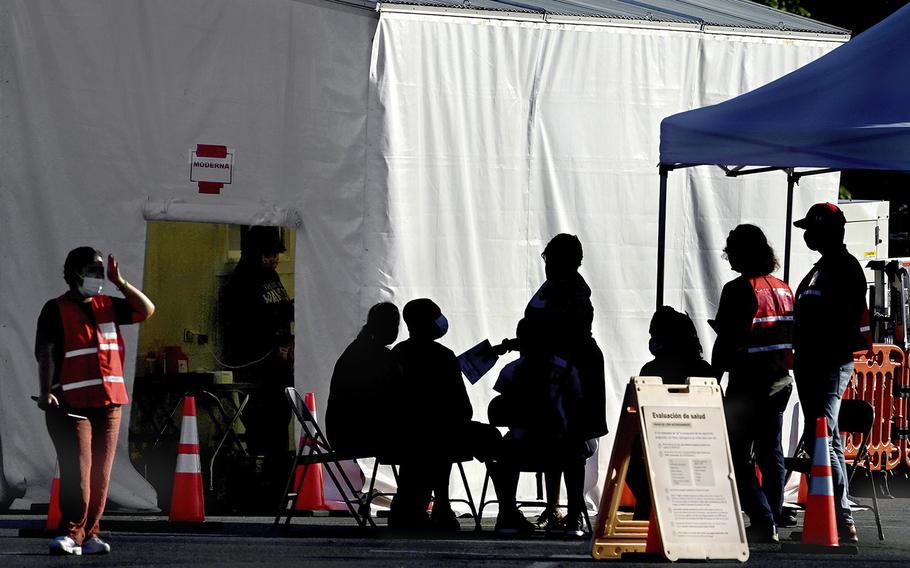
A mobile clinic offers free coronavirus vaccinations in the Lakeforest Mall parking lot in Gaithersburg, Md., on June 25, 2021. (Michael S. Williamson/Washington Post)
Meanwhile, more challenges emerged as the delta surge gave way to a new variant: omicron. The new variant was even more contagious, spreading rapidly among the vaccinated, who continued to enjoy protection against hospitalization and death. The White House raced to respond, enacting travel restrictions over Thanksgiving weekend when most of the world had not even heard of the latest mutation.
Yet another problem emerged: As people struggled to protect their families before the holidays, they found store shelves barren of tests. The White House, as one senior administration official put it, had been "caught flat-footed."
Biden was furious. In meetings in the Oval Office, an exasperated Biden repeatedly asked, "Why didn't we order enough tests? Why didn't we order enough of what we needed?"
That summer, as covid had seemed to recede, testing manufacturers had slowed their production of at-home tests. Covid modeling at the time had anticipated that vaccines would lower the rate of new infections, and Abbott Laboratories had even destroyed millions of rapid tests and laid off employees during that stretch.
One former administration official involved in the process, however, said the problem was not one of a failure to plan, but one of capacity: There weren't enough at-home tests available to order for the winter months ahead, even had the administration wanted to. A second administration official added that there were no at-home tests available to consumers on the market when Biden took office, so the administration was forced to play catch-up - yet still managed to go from zero to at least a dozen brands in his first year, with 19 currently on the market.
Either way, the mistake proved costly.
"Coming in after Trump, regarding covid, we knew we had to lead with competence, and the testing debacle undermined that competence," said someone involved in the response.
Other unexpected challenges were also bedeviling the administration, including a nationwide shortage of baby formula, which became a full-blown political crisis for Biden by May. Although industry leaders knew of a coming shortage as early as February, there was a breakdown in communication between the Food and Drug Administration and the White House about the issue. Biden did not learn of the crisis until April.
As questions about the baby formula shortage dominated the daily White House news briefing, Biden invoked the Defense Production Act to help ramp up formula production at home and also authorized the airlifting of formula from foreign countries.
White House aides asked Vice President Harris to meet the first shipment of formula from abroad - a symbolic photo opportunity, but one that would inadvertently link her to yet another administration crisis.
The request illustrated the ongoing tension between the West Wing and the vice president's office, stemming from the inherently ill-defined role of a president's No. 2.
Biden's selection of Harris made history, elevating the first Black and Indian American woman to the role of vice president. But her tenure has been marked by concerns about her management style - fueled by an almost complete turnover of her senior staff - a nebulous portfolio leaving her without signature policy accomplishments, and persistent doubts about her ability to lead the Democratic Party into the future.
Ultimately, Harris refused to meet the baby formula shipment, so Agriculture Secretary Tom Vilsack went instead. A Harris aide said she greeted a later shipment of baby formula.
The vice president's office disputed the characterization of Harris's contributions, touting her work in Central America to coordinate the response to a surge in migration, how she shaped an infrastructure law to expand broadband access, and her leadership role on reproductive rights and expanding access to abortion.
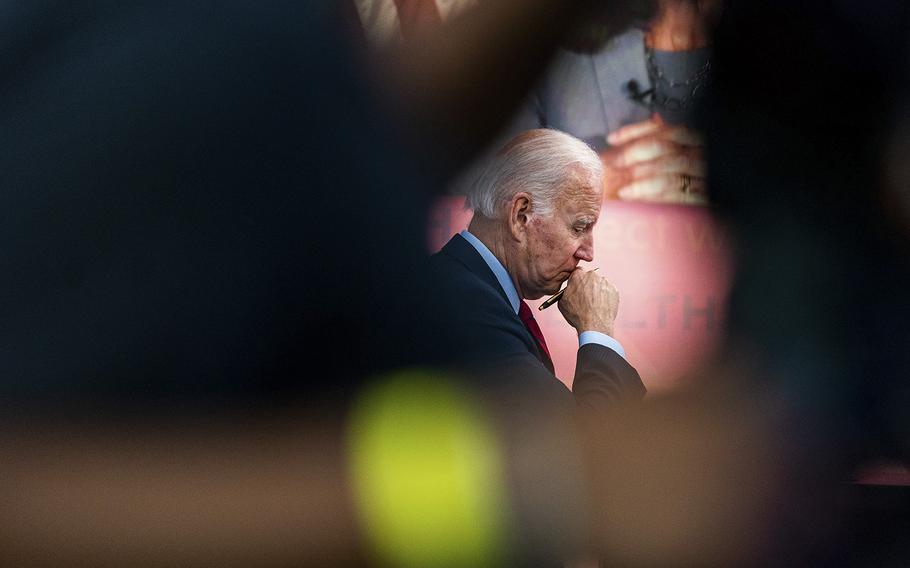
Prsident Biden convenes a virtual meeting with governors to discuss efforts to protect access to reproductive health care on July 1, 2022, shortly after the Supreme Court overturned Roe v. Wade. (Demetrius Freeman/Washington Post)
In a statement, White House spokesman Andrew Bates said, "The Vice President has been core to our historic successes and the President is grateful for her leadership and full partnership every day."
By March, the administration began to take steps to regain its legislative footing. Commerce Secretary Gina Raimondo held a private dinner that month at her Georgetown home, personally preparing a pork roast for Manchin and Klain.
At the meal, Klain apologized to Manchin for how the White House had handled the breakdown of legislative negotiations, which included the blistering statement.
"I'm sorry if those statements offended you, or made you feel like we were coming after you," Klain told Manchin, according to one person familiar with the comments. "We didn't mean any offense."
The detente repaired the fractured relationship. And, more important, it laid the groundwork for an eventual 11th hour deal that capped an eight-week stretch of propulsive legislative successes for the administration: The first federal gun safety bill in 28 years. Billions of dollars to spur the development of a domestic semiconductor industry. A significant expansion of health care for veterans. And a sweeping bill that invests billions of dollars to combat climate change and aims to reduce the costs of prescription drugs.
White House aides argue the fixation on Democratic infighting early in Biden's tenure obscured the delicate political work they were engaged in behind the scenes, managing the sometimes-competing interests of the liberal and moderate wings of the party, with little room for defections.
Biden himself, for instance, spent time whipping votes, calling a list of reluctant liberal House lawmakers and highlighting the projects that would benefit their states and districts ahead of the passage of the infrastructure law, one senior adviser said.
Ultimately, White House advisers argue their success in getting nearly every Democrat to vote for the president's legislative agenda should be celebrated.
"What I see was a strategy we ran that succeeded in us getting more legislation passed in two years than any administration in modern times, with the narrowest majority in the history in both the House and the Senate," a senior White House adviser said.
Millions of veterans who were exposed to burn pits are now eligible for expanded health care. Starting next year, senior citizens on Medicare will not have to pay more than $35 a month for insulin. Americans can now purchase hearing aids over the counter at pharmacies. The infrastructure law will spur repairs of 65,000 miles of roads and 1,500 bridges this year and, over time, expand broadband access across the country. The new climate law could save Americans thousands of dollars through rebates and tax credits for using renewable energy, electric vehicles and making other climate-friendly improvements to their homes.
As Biden kept racking up wins, the president's mood lifted - and White House aides felt the darkness that had clouded much of their first year dissipate. Inside the West Wing, aides obsessively followed the FiveThirtyEight average of national polls, their moods rising with the tiniest shifts upward.
Gone were the headlines of Democratic infighting. Now, Biden touted campaign promises fulfilled. Even casualties of that first year, like former Virginia Gov. Terry McAuliffe (D), who last fall lost his bid to reclaim his office in a state Biden had won by 10 percentage points, began to see the shift.
"Going through the fall, the Democrats looked like they were just constantly fighting one another, and they couldn't get bills passed," McAuliffe said. "And I think the American public looked at - these guys got control of the House, Senate, White House. If they can't get anything done, why should they have any power?"
In early spring, Biden sat in his private dining room with senior advisers and eviscerated the Republican Party. He expressed his concerns about the party's continued embrace of election conspiracy theories, and lamented how the extremist and far-right factions had overtaken their party to drown out more-moderate Republicans.
Biden made clear he wanted to distinguish more sharply the different factions of the Republican Party and build on an argument he had been making for years: "This is not your father's Republican Party."
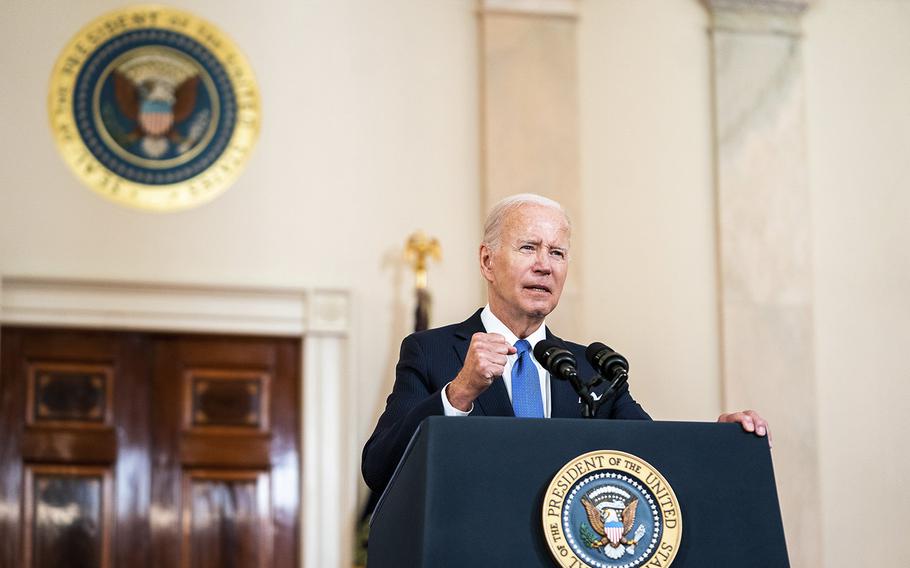
President Biden delivers remarks at the White House on June 24, 2022, regarding the Supreme Court’s overturning of Roe v. Wade. (Demetrius Freeman/Washington Post)
Biden and his aides eventually settled on describing the Republicans as pushing an "ultra-MAGA" agenda, a reference to Trump's "Make America Great Again" slogan. The ultra-MAGA phrase was the result of a six-month research project led by Anita Dunn, who rejoined the White House as a senior adviser in the spring, and the Center for American Progress Action Fund, a liberal group.
But the most seismic shift for Biden and the Democrats - and arguably the country - came from the third branch of government: the Supreme Court's decision to overturn Roe v. Wade.
At first, Biden and his top aides were slow to act.
White House officials had a two-month head start to plan for the post-Roe landscape, after a draft opinion of the decision was leaked. But as senior aides sat in the president's office on June 23, two White House officials said they believed they had an extra week to put into action the plan they were hoping to finalize, wrongly believing the court would wait until the end of its session to rule.
Instead, the court ruled the next day, setting off a scramble inside the West Wing. Biden had already approved his remarks for the decision, but all of the executive actions were not ready.
Jen Klein, director of the Gender Policy Council, denies that the White House was caught off guard, saying in a statement, "We were absolutely prepared." In an interview, she said advisers were unsure whether the draft opinion would be identical to the final ruling, and needed time make sure any executive actions could withstand legal challenges.
"We were just trying to do all of the work we could do to be ready, while holding and waiting for the opportunity to actually read the decision and respond to it adequately," she said.
Many Democrats were disappointed by Biden's initial response. And even inside the White House, staffers - including some of the president's top advisers - thought the speech lacked the forcefulness needed at that moment.
Biden, a devout Catholic, has long been out of step with his party on abortion and has often struggled to lead on the issue. But Donilon, Biden's longtime adviser - who is also Catholic and who Biden trusts deeply - urged the president to take a more forceful stance. Donilon also counseled aides not to worry about Biden's initially lackluster response, arguing that the overturning of Roe was a tectonic event, fundamentally altering the political landscape and mobilizing Democrats.
Donilon's insight proved to be prescient. In August, voters in Kansas, a reliably conservative state, turned out in droves to reject an amendment that would have stripped away the state's abortion protections.
As the election was getting closer, Biden's standing continued to slowly rise. Inflation and covid were still present, but fading, and the president found himself again with a clear direction and message.
"Across every measure of how you respond to a pandemic, we've seen dramatic improvements to get the virus under control," said Ashish Jha, the White House covid coordinator, noting that deaths from the virus are down 90 percent and the economy and schools are fully reopened.
White House officials also argue that their success on fighting the pandemic came despite stiff opposition from leading Republicans, who undermined confidence in vaccines and blocked funding for the response.
During the 2020 campaign, Biden would brim with confidence, telling advisers there were only three ways he would lose to Trump: "I screw up, he steals the election, or I get covid."
By early last month, aides again believed the national environment was tacking back in their direction: The decision to overturn Roe. The public Jan. 6 hearings. The FBI search of Trump's Mar-a-Lago residence and the discovery that the former president took more than 700 pages of classified documents from the White House.
Biden's vow to restore American leadership on the world stage also came to fruition in the months following Russia's unprovoked invasion of Ukraine in late February, in what aides attribute to steps that had been taken before the war began.
In the run-up to the invasion, the White House debuted creative intelligence-sharing strategies, unified European allies against Russia, readied military and financial aid for Ukraine, and prepared some of the harshest and most severe sanctions ever levied against Russia.
A pivotal moment came at the end of last October, during a meeting Biden requested with the leaders of Britain, France and Germany during the Group of 20 summit in Rome. In a private room, Biden walked the leaders through new U.S. intelligence, explaining in granular detail what the Russians were planning and contemplating.
"It was eye-opening for his counterparts, and it was really at that meeting that there was agreement to start work immediately to do two things - one was to try to prevent Russia from going forward with their aggression, but at the same time to prepare for what to do if they did so anyway," Secretary of State Antony Blinken said. "We were able to plan and prepare."
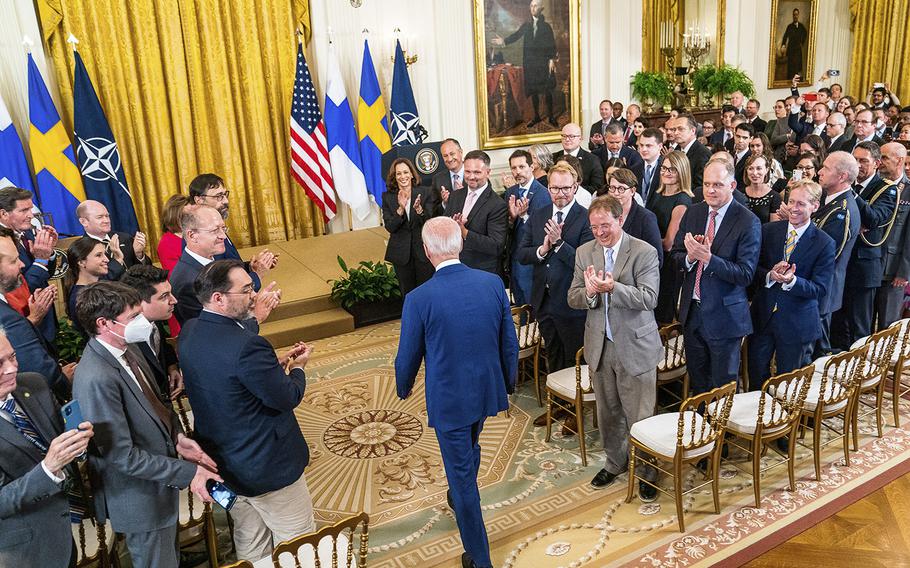
President Biden arrives in the East Room of the White House on Aug. 9, 2022, to sign documents starting the process of admitting Finland and Sweden to NATO. (Demetrius Freeman/Washington Post)
After the invasion, Biden strengthened the transatlantic alliance and united much of the world against Russia. NATO is now set to expand by two countries: Finland and Sweden.
Biden also took executive actions aimed at younger voters: canceling up to $20,000 of student debt - more than 8 million people have already applied - and offering mass pardons for anyone convicted of a federal crime for simply possessing marijuana, while urging governors to do the same.
Many aides privately admit they wish all the recent successes came sooner and easier - without the messy Afghanistan withdrawal, without the Democratic infighting, and without the cascade of coronavirus variants. Biden himself eventually succumbed to the virus, testing positive in July, though he recovered without incident.
"Part of what's in the DNA of the team is that he's had to play through some really rough moments, for a long period of time," Donilon said. "Obviously we went through a long period of time during the campaign when it didn't look so good. It was true during the campaign and it's true during the presidency."
The Washington Post's Emily Guskin contributed to this report.